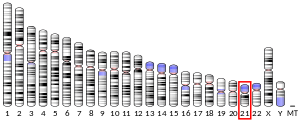Histone H2B type F-S is a protein that in humans is encoded by the H2BFS gene.[3]
Further reading
- Frohm M, Gunne H, Bergman AC, Agerberth B, Bergman T, Boman A, Lidén S, Jörnvall H, Boman HG (April 1996). "Biochemical and antibacterial analysis of human wound and blister fluid". European Journal of Biochemistry / FEBS. 237 (1): 86–92. doi:10.1111/j.1432-1033.1996.0086n.x. PMID 8620898.
- El Kharroubi A, Piras G, Zensen R, Martin MA (May 1998). "Transcriptional activation of the integrated chromatin-associated human immunodeficiency virus type 1 promoter". Molecular and Cellular Biology. 18 (5): 2535–44. doi:10.1128/mcb.18.5.2535. PMC 110633. PMID 9566873.
- Deng L, de la Fuente C, Fu P, Wang L, Donnelly R, Wade JD, Lambert P, Li H, Lee CG, Kashanchi F (November 2000). "Acetylation of HIV-1 Tat by CBP/P300 increases transcription of integrated HIV-1 genome and enhances binding to core histones". Virology. 277 (2): 278–95. doi:10.1006/viro.2000.0593. PMID 11080476.
- Deng L, Wang D, de la Fuente C, Wang L, Li H, Lee CG, Donnelly R, Wade JD, Lambert P, Kashanchi F (October 2001). "Enhancement of the p300 HAT activity by HIV-1 Tat on chromatin DNA". Virology. 289 (2): 312–26. doi:10.1006/viro.2001.1129. PMID 11689053.
- Kim HS, Cho JH, Park HW, Yoon H, Kim MS, Kim SC (March 2002). "Endotoxin-neutralizing antimicrobial proteins of the human placenta". Journal of Immunology. 168 (5): 2356–64. doi:10.4049/jimmunol.168.5.2356. PMID 11859126.
- Cheung WL, Ajiro K, Samejima K, Kloc M, Cheung P, Mizzen CA, Beeser A, Etkin LD, Chernoff J, Earnshaw WC, Allis CD (May 2003). "Apoptotic phosphorylation of histone H2B is mediated by mammalian sterile twenty kinase". Cell. 113 (4): 507–17. doi:10.1016/S0092-8674(03)00355-6. PMID 12757711.
- Tollin M, Bergman P, Svenberg T, Jörnvall H, Gudmundsson GH, Agerberth B (April 2003). "Antimicrobial peptides in the first line defence of human colon mucosa". Peptides. 24 (4): 523–30. doi:10.1016/S0196-9781(03)00114-1. PMID 12860195.
- Lusic M, Marcello A, Cereseto A, Giacca M (December 2003). "Regulation of HIV-1 gene expression by histone acetylation and factor recruitment at the LTR promoter". The EMBO Journal. 22 (24): 6550–61. doi:10.1093/emboj/cdg631. PMC 291826. PMID 14657027.
- Howell SJ, Wilk D, Yadav SP, Bevins CL (November 2003). "Antimicrobial polypeptides of the human colonic epithelium". Peptides. 24 (11): 1763–70. doi:10.1016/j.peptides.2003.07.028. PMID 15019208.
- Golebiowski F, Kasprzak KS (November 2005). "Inhibition of core histones acetylation by carcinogenic nickel(II)". Molecular and Cellular Biochemistry. 279 (1–2): 133–9. doi:10.1007/s11010-005-8285-1. PMID 16283522.
- Zhu B, Zheng Y, Pham AD, Mandal SS, Erdjument-Bromage H, Tempst P, Reinberg D (November 2005). "Monoubiquitination of human histone H2B: the factors involved and their roles in HOX gene regulation". Molecular Cell. 20 (4): 601–11. doi:10.1016/j.molcel.2005.09.025. PMID 16307923.
- Beck HC, Nielsen EC, Matthiesen R, Jensen LH, Sehested M, Finn P, Grauslund M, Hansen AM, Jensen ON (July 2006). "Quantitative proteomic analysis of post-translational modifications of human histones". Molecular & Cellular Proteomics. 5 (7): 1314–25. doi:10.1074/mcp.M600007-MCP200. PMID 16627869.
- Pavri R, Zhu B, Li G, Trojer P, Mandal S, Shilatifard A, Reinberg D (May 2006). "Histone H2B monoubiquitination functions cooperatively with FACT to regulate elongation by RNA polymerase II". Cell. 125 (4): 703–17. doi:10.1016/j.cell.2006.04.029. PMID 16713563.
- Kim SC, Sprung R, Chen Y, Xu Y, Ball H, Pei J, Cheng T, Kho Y, Xiao H, Xiao L, Grishin NV, White M, Yang XJ, Zhao Y (August 2006). "Substrate and functional diversity of lysine acetylation revealed by a proteomics survey". Molecular Cell. 23 (4): 607–18. doi:10.1016/j.molcel.2006.06.026. PMID 16916647.

